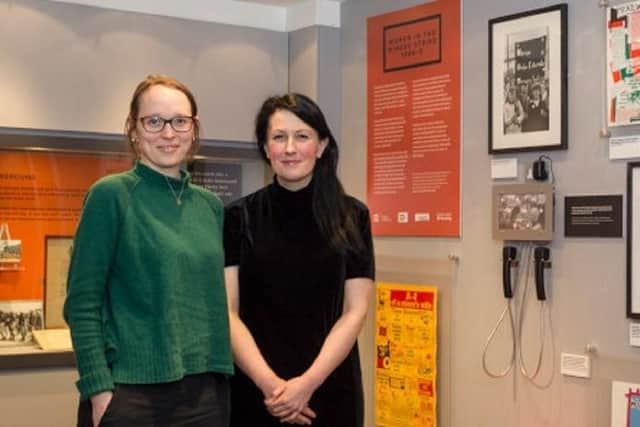Yorkshire historian on women's different stances to the miners' strike
The industrial dispute regarded as one of the most bitter that Britain had ever seen had come to an end a year before Dr Natalie Thomlinson was born.
But as the grand-daughter of a mineworker, and someone who grew up in Doncaster, an area once brimming with coal mines, she heard story after story about the miners' strike of 1984 to 1985 and what life was like in a year that saw many of the industry’s workers take a stand against plans to shut down collieries.
Advertisement
Hide AdAdvertisement
Hide AdYears later, and now a historian of feminism and gender and an Associate Professor of Modern British Cultural History at the University of Reading, Dr Thomlinson has been leading research to find out more about that pivotal year, hearing the story told from the perspective of women.


"Even today in 2023, working class women’s history does not get told as much as it should,” she says. “I want people to have a snapshot of life in working class communities, in coalfield communities in the 1980s and to have a sense of what those lives were like for women.”
In 2018, Natalie became a co-investigator on the Arts and Humanities Research Council-funded project 'Women and the miners' strike: Capturing changing gender roles in working-class communities in Britain after 1945', alongside Florence Sutcliffe-Braithwaite at University College London.
They and their team interviewed about 100 women from previous mining communities across Britain and asked them about their experiences during the 1984 to 1985 strike. The work has recently been published as the book Women and the Miners' Strike, 1984-1985, exploring the different stances and actions that women took during the dispute.
Advertisement
Hide AdAdvertisement
Hide AdWhilst many of the strikers themselves were men, there were some women – cooks, cleaners and office workers, for example – who went on strike too. Others, not working in the industry, began to meet just days into the action to consider how women in coalfield communities could support the strike. Ultimately, they formed a national network of groups, taking on roles such as setting up soup kitchens, distributing parcels of food and clothing, raising funds, joining marches, giving speeches and standing on picket lines.
“Women’s participation in supporting the strike, or indeed not supporting it, mirrored their increasing participation within what we might think of the public sphere - the world of politics and trade union activism,” Dr Thomlinson says.
“Quite a number of those women [who supported the strike] denied they were political even though they were involved in activities that you would see as political and that was really interesting because it suggested something about the way in which politics was seen as ‘a dirty word’…
"The way in which the women’s support group could be most powerful and make their voices heard most was by saying they weren’t political, by saying they were ordinary women acting in defence of their communities. They were more likely to be listened to.”
Advertisement
Hide AdAdvertisement
Hide AdThe book tells how many women from mining families didn’t get involved in much, if any activism but gave their support to the strike in other ways, keeping the home and family going, and going out to work to bring in a wage.
“You see a big change in the 60s, 70s and 80s in the number of women going out to work,” Dr Thomlinson says. “By this point in 84-85, there’s enough women who are going out to work to be able to keep families afloat even when the male wage from mining wasn't coming in. It’s not really talked about very much but it’s one of the main factors that allowed the strike to keep going for a year and that’s something we argue in the book.”
The authors also share experiences of women whose husbands of fathers worked through the strike or returned to work early, arguing their voices have been “almost entirely obscured within popular memory”.
They say these groups “refashioned concepts like democracy and community to justify their actions”, with some forming their own support networks to help others in their communities who came under fire for opposing the strike.
Advertisement
Hide AdAdvertisement
Hide Ad“Their perspectives were also really interesting,” Dr Thomlinson says. “It’s important to remember the strike was really contentious. Not everyone supported it and it did cause divisions within communities.”
She adds: “For sure, what the women in the support group did was really incredible and we don’t want to lose that…But we were also trying to understand the stories of people who maybe were more ambivalent about the strike and the ways in which the support movement itself had internal divisions.”
For Dr Thomlinson, the work provided an opportunity to return to her hometown to hear from those with direct recollections of the strike in a coalfield community.
She is particularly proud of her team’s work to capture oral history recordings from women up and down the country.
Advertisement
Hide AdAdvertisement
Hide AdThroughout much of 2020, their testimonies were shared at an exhibition at the Yorkshire-based National Coal Mining, as well as online, and the interviews will be archived at the museum.
"I've been genuinely very proud to be able to create a large archive of working class women's history,” Dr Thomlinson said in an interview with the University of Reading.
“This is a huge resource now where people can go and listen to these interviews and hear about women's lives in their own words. It's really great to be able to see a piece of research which, yes, will have an academic output but also has a life in the world outside the university."
Women and the Miners' Strike, 1984-1985, by Dr Florence Sutcliffe-Braithwaite and Dr Natalie Thomlinson, is published by Oxford University Press and out now.
